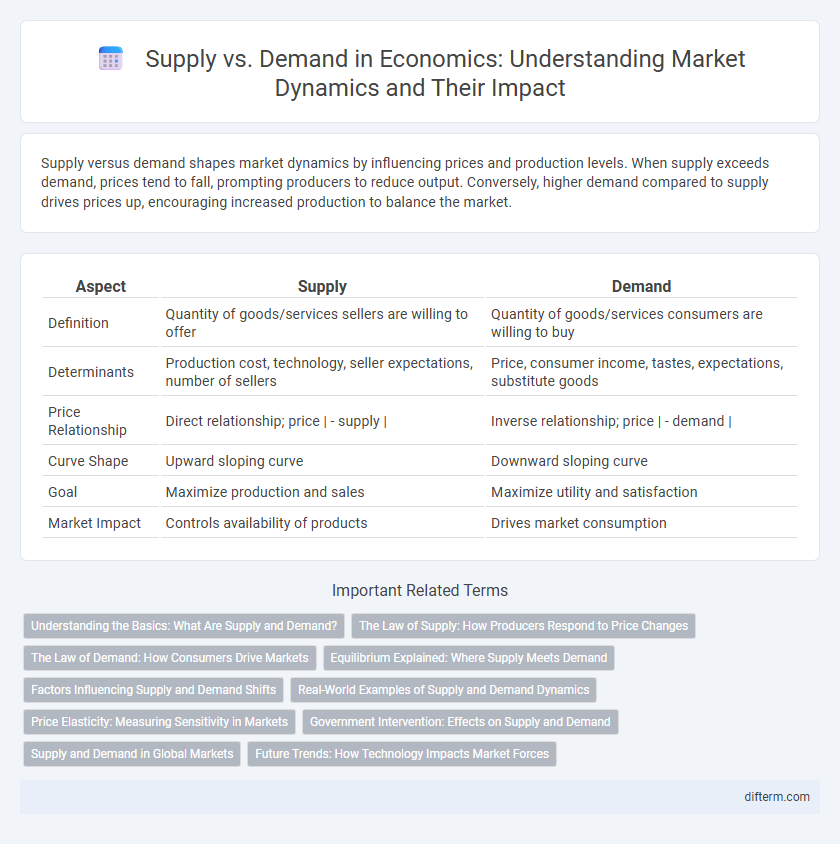Supply versus demand shapes market dynamics by influencing prices and production levels. When supply exceeds demand, prices tend to fall, prompting producers to reduce output. Conversely, higher demand compared to supply drives prices up, encouraging increased production to balance the market.
Table of Comparison
| Aspect | Supply | Demand |
|---|---|---|
| Definition | Quantity of goods/services sellers are willing to offer | Quantity of goods/services consumers are willing to buy |
| Determinants | Production cost, technology, seller expectations, number of sellers | Price, consumer income, tastes, expectations, substitute goods |
| Price Relationship | Direct relationship; price | - supply | | Inverse relationship; price | - demand | |
| Curve Shape | Upward sloping curve | Downward sloping curve |
| Goal | Maximize production and sales | Maximize utility and satisfaction |
| Market Impact | Controls availability of products | Drives market consumption |
Understanding the Basics: What Are Supply and Demand?
Supply refers to the quantity of goods or services that producers are willing to sell at various price levels, while demand is the amount consumers are willing to purchase at those prices. The interaction between supply and demand determines market prices and quantities, creating equilibrium where the quantity supplied equals the quantity demanded. Understanding these fundamental concepts explains price fluctuations, resource allocation, and consumer behavior in economic markets.
The Law of Supply: How Producers Respond to Price Changes
The Law of Supply explains that producers increase the quantity of goods supplied when prices rise, leveraging higher potential profits to expand production. This direct relationship between price and quantity supplied helps balance market dynamics by encouraging supply adjustments in response to changing demand conditions. Efficient resource allocation emerges as producers respond to price incentives, optimizing output to meet consumer needs.
The Law of Demand: How Consumers Drive Markets
The Law of Demand states that as the price of a good or service decreases, consumer demand generally increases, reflecting direct market behavior. Price elasticity plays a crucial role in shaping this relationship, with highly elastic goods witnessing significant shifts in quantity demanded. Consumer preferences and income levels further influence demand dynamics, driving overall market equilibrium.
Equilibrium Explained: Where Supply Meets Demand
Equilibrium in economics is the point where supply matches demand, resulting in a stable market price. At this intersection, the quantity of goods producers are willing to sell equals the quantity consumers want to buy, preventing shortages or surpluses. Understanding this balance is crucial for analyzing market efficiency and predicting price fluctuations.
Factors Influencing Supply and Demand Shifts
Shifts in supply and demand are influenced by factors such as changes in production costs, technological advancements, consumer preferences, and income levels. External events like government policies, taxes, subsidies, and global market trends also play critical roles in altering supply chains and buying behaviors. Seasonal variations and expectations about future prices further contribute to fluctuations in supply and demand curves.
Real-World Examples of Supply and Demand Dynamics
The housing market in major cities like San Francisco and New York illustrates supply and demand dynamics, where limited housing supply amid high demand drives up prices considerably. During the 2020 semiconductor shortage, global electronics manufacturers faced constrained chip supply, leading to increased costs and delays in product delivery. Agricultural markets also demonstrate this, as adverse weather conditions reduce crop yields, decreasing supply and increasing food prices in response to sustained demand.
Price Elasticity: Measuring Sensitivity in Markets
Price elasticity of demand quantifies how quantity demanded changes in response to price shifts, reflecting consumer sensitivity in markets. A high price elasticity indicates consumers are responsive, leading to significant demand fluctuations when prices change, while low elasticity suggests demand remains stable despite price variations. Businesses use this metric to optimize pricing strategies, maximizing revenue and market efficiency.
Government Intervention: Effects on Supply and Demand
Government intervention through policies such as subsidies, taxes, and price controls directly affects supply and demand by altering production costs and consumer prices. Price ceilings can lead to shortages by increasing demand while limiting supply, whereas price floors may cause surpluses by encouraging excess supply and reducing demand. Regulatory measures, including import restrictions and minimum wage laws, shift market equilibrium, often resulting in unintended consequences like market distortions and reduced economic efficiency.
Supply and Demand in Global Markets
Global markets experience fluctuating supply and demand dynamics influenced by geopolitical events, trade policies, and technological advancements. Supply constraints, such as raw material shortages or production disruptions, can lead to price volatility and impact international trade balances. Demand shifts driven by consumer preferences, emerging economies, and global economic growth rates critically shape market stability and resource allocation.
Future Trends: How Technology Impacts Market Forces
Emerging technologies such as artificial intelligence and blockchain are reshaping supply chain efficiency and transparency, driving a more responsive alignment between supply and demand. Automation and predictive analytics enhance production scalability while real-time consumer data refines demand forecasting, minimizing inventory waste and market imbalances. The integration of Internet of Things (IoT) devices further accelerates adaptive supply management, fostering dynamic pricing models and accelerating shifts in market equilibrium.
Supply vs Demand Infographic

 difterm.com
difterm.com